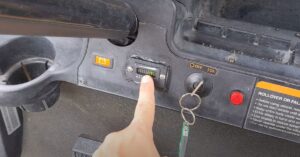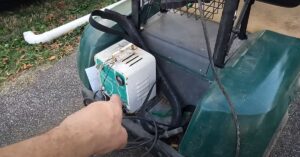How To Revive Golf Cart Batteries?
Are you frustrated with your golf cart battery dying too soon? Don’t fret! There’s a solution to breathe life back into those seemingly dead batteries. With the right knowledge and a little effort, you can revive your golf cart batteries and keep them running longer.
The process of reviving golf cart batteries involves discharging them fully before recharging. This cycle helps restore their capacity, ensuring they last longer and perform better.
Curious about how this works in detail? Continue reading as we break down the steps for you, making it easy to follow along. You’ll be amazed at what a difference this simple trick can make to your golf game!
Key Takeaways
- Proper maintenance and regular charging are essential for extending the lifespan of golf cart batteries.
- Reviving a dead battery may be possible through deep cycling or using desulfation techniques.
- It’s crucial to follow safety precautions and consult manufacturer guidelines when attempting to revive golf cart batteries.
- Investing in high-quality batteries and proper storage can help prevent premature battery failure and the need for revival methods.
How to Determine if Your Golf Cart Battery Can Be Revived
Is your golf cart battery giving you trouble? Before you rush to replace it, let’s find out if there’s a chance to revive it. Determining whether your golf cart battery can be revived involves assessing its age, capacity, and overall condition.
Age
One of the key factors in determining if a golf cart battery can be revived is its age. Generally, batteries older than five years may not respond well to revival methods due to natural wear and tear.
Capacity
Assessing the battery’s capacity is crucial. If your battery consistently fails to hold a charge or provides insufficient power for your golf cart, it may be beyond revival.
Condition
Take a closer look at the physical condition of the battery. Signs such as bulging or leaking indicate internal damage that cannot be easily fixed.
Voltage Test
Performing a voltage test is an effective way to determine if the battery has any life left in it. Use a multimeter to measure the voltage output; anything below 10 volts suggests significant deterioration.
By considering these aspects, you can make an informed decision about reviving or replacing your golf cart battery.
Step-by-Step Guide on Reviving Golf Cart Batteries
Is your golf cart battery not performing as well as it used to? Don’t worry, we’ve got you covered! In this guide, we will walk you through the step-by-step process of reviving your golf cart batteries and getting them back to their optimal performance.
To begin with, let’s gather all the necessary tools and materials. You will need safety glasses, gloves, a voltmeter or multimeter, distilled water, baking soda, a clean cloth or sponge, and a battery charger.
Next, assess the condition of your battery by checking its voltage using the voltmeter. If the voltage is below 12 volts, it indicates that your battery needs to be revived.
Once you have confirmed that your battery requires reviving, start by removing any corrosion present on the terminals. Mix a solution of baking soda and water and use it to clean the terminals thoroughly. Rinse with distilled water afterward.
Now comes the crucial step of adding distilled water to each cell in the battery. Remove any caps or plugs from these cells before carefully filling them up with distilled water. Be sure not to overfill!
After adding distilled water, connect your battery charger and set it to a low amp charge mode. Let it charge for at least 24 hours or until fully charged.
Once fully charged, disconnect the charger and reinstall any caps or plugs that were removed earlier. Clean off any excess moisture from the surface of the battery using a clean cloth or sponge.
Congratulations! Your golf cart battery has been successfully revived. Remember to regularly maintain and monitor its performance in order to ensure long-lasting efficiency.
By following these simple steps outlined above in our step-by-step guide on reviving golf cart batteries,
you can save money by extending their lifespan instead of purchasing new ones unnecessarily.
Common Mistakes to Avoid When Trying to Revive Golf Cart Batteries
Reviving golf cart batteries can be a cost-effective solution, but it’s important to avoid common mistakes that could hinder your efforts. Here are some key pitfalls to steer clear of when trying to revive golf cart batteries.
Overlooking the underlying issue
Before attempting any revival methods, it’s crucial to assess why the battery died in the first place. Often, a dead battery is a symptom of an underlying problem such as corroded terminals or a faulty charger. Addressing these issues first will increase your chances of success.
Using incorrect charging techniques
One mistake many people make is using the wrong charging technique for their particular type of battery. Each battery has specific voltage and amperage requirements that need to be followed precisely. Failing to do so can lead to overcharging or undercharging, which can permanently damage the battery.
Neglecting maintenance
Regular maintenance plays a vital role in extending the lifespan of your golf cart batteries. Ignoring routine tasks such as cleaning terminals, checking water levels (for flooded lead-acid batteries), and inspecting for signs of wear and tear can result in reduced performance and premature failure.
Rushing the process
Reviving a golf cart battery takes time and patience; rushing through the process is another common mistake that should be avoided. Allow enough time for each step, whether it’s desulfating, equalizing, or reconditioning the battery cells. Skipping steps or cutting corners may yield temporary results at best.
Tips for Maintaining and Extending the Lifespan of Revived Golf Cart Batteries
Reviving your golf cart batteries can save you money and ensure your cart performs optimally on the green. But just reviving them is not enough; proper maintenance is essential to extend their lifespan. Here are some valuable tips to help you achieve that.
Regularly Check Water Levels
Water plays a crucial role in keeping your revived golf cart batteries healthy. Make it a habit to check the water level every month or as recommended by the manufacturer. Use distilled water to refill any cells that are low, ensuring they are adequately covered.
Keep Batteries Clean
Dirt and corrosion can hinder battery performance, so keep them clean at all times. Use a mixture of baking soda and water to gently scrub away any dirt or residue from the terminals and cables. Rinse with clean water afterward, making sure everything is dry before reconnecting.
Avoid Overcharging
Overcharging can significantly reduce battery life, so be mindful of how long you leave your batteries plugged in for charging. Invest in a smart charger that automatically switches off when fully charged or set an alarm as a reminder.
Store Properly during Off-Seasons
If you won’t be using your golf cart for an extended period, store the batteries properly to prevent damage or deterioration. Ensure they are fully charged before storing in a cool, dry place away from direct sunlight.
Perform Regular Equalization Charges
Equalization charges help balance out voltage levels among cells and prevent sulfation buildup. Follow manufacturer guidelines on how often you should perform equalization charges for maximum effectiveness.
Exploring Other Options: Is it Time to Replace Your Golf Cart Battery?
If you’re wondering whether it’s time to replace your golf cart battery, let’s dig deeper into the signs that may indicate a need for a change. A worn-out battery can affect the performance of your golf cart and hinder your overall experience on the course. Here are some reasons why considering a replacement might be necessary:
Decreased Performance
If you notice that your golf cart is not running as smoothly or efficiently as before, it could be due to an aging battery. Diminished power output can lead to slower speeds and reduced distance coverage.
Inadequate Run Time
As batteries age, their capacity gradually decreases. If you find yourself needing frequent recharges during a round of golf or if the run time has significantly shortened compared to when the battery was new, this could be a sign that replacement is needed.Frequent Maintenance Issues
Aging batteries often require more maintenance and attention than newer ones. If you find yourself constantly dealing with issues like acid leaks, corrosion, or cells failing to hold a charge despite proper care, it might be time for an upgrade.
Longevity
Golf cart batteries typically have a lifespan of around 5-7 years depending on usage and maintenance practices. If your current battery is nearing this range or has already surpassed it, replacing it sooner rather than later will ensure uninterrupted enjoyment during your rounds.
FAQs
Q: What are the common reasons for golf cart batteries dying?
A: Golf cart batteries commonly die due to excessive discharge, lack of maintenance, or old age. Over time, sulfation can also build up on the battery plates, reducing their capacity and performance.
Q: How can I revive a golf cart battery?
A: One method to revive a golf cart battery is by using an equalization charge. This involves charging the battery at a higher voltage for a longer period of time, which helps break down sulfation and restore its capacity. Another option is adding distilled water to the cells if they are low on electrolyte.
Q: Are there any preventive measures to extend the life of golf cart batteries?
A: Yes, there are several preventive measures that can help prolong the life of golf cart batteries. These include regularly recharging after each use, avoiding deep discharges, keeping them clean and dry, and performing regular maintenance such as checking fluid levels and cleaning terminal connections.
Q: Can I use other methods besides equalization charging to revive my golf cart battery?
A: Yes, besides equalization charging, you can try desulfating additives or using a desulfator device specifically designed for golf cart batteries. These methods aim to break down sulfation and improve battery performance. However, it’s important to note that not all batteries may respond effectively to these alternative methods.




![How To Charge A Golf Cart With Dead Batteries? [A Comprehensive Guide] how-to-charge-a-golf-cart-with-dead-batteries](https://giftedgolfers.com/wp-content/uploads/2023/06/how-to-charge-a-golf-cart-with-dead-batteries-300x157.jpg)